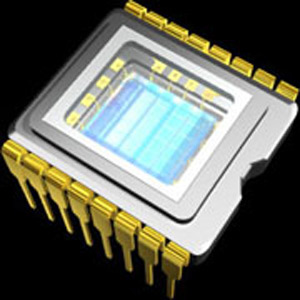charge-coupled device (CCD)

A charge-coupled device (CCD) is a small photoelectronic imaging device (typically 1.5 centimeter square) made from a crystal of silicon in which numerous (at least 250,000) individual light-sensitive picture elements (pixels) have been fabricated. Each pixel (less than 0.03 millimeter in size) is capable of storing electronic charges created by the absorption of light. The name derives from the method of extracting the locally stored charges from each pixel, which is done by transferring or "coupling" charges from one pixel to the next by the controlled collapse and growth of adjacent storage sites or potential wells. Each well is formed inside the silicon crystal by the electric field generated by voltages applied to tiny, semi-transparent metallic electrodes on the CCD surface. CCDs, placed at the receiving end of telescopes to take pictures of very faint astronomical objects, have almost completely superceded photographic plates for professional use. A CCD spectrometer is an instrument that uses a modified CCD to obtain images and spectra of X-ray sources.


